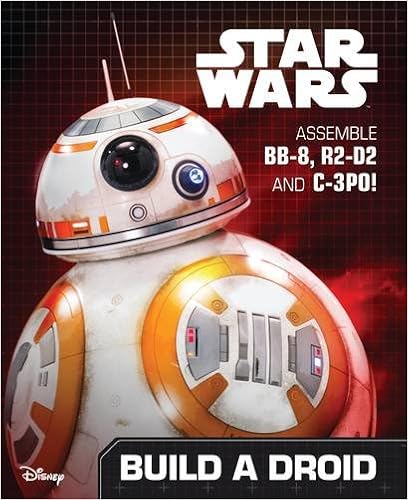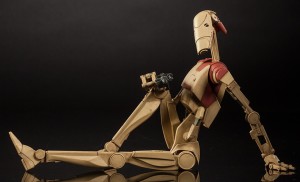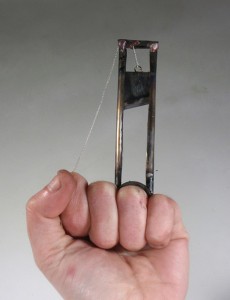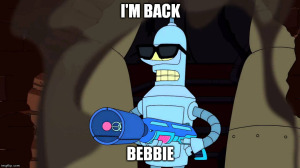Review: Star Wars Build A Droid (or, Build Your Favourite, Mix And Match The Other Two)
Well well. Now this is a fairly generous helping of droids. This edition of Build A Droid (there are several other books like this, just to be clear about which one we’re on about) by Egmont Publishing, sees you make laminated cardboard copies of, well, Artoo, Threepio and … BB-8? How come we haven’t made a wordy nickname for the little beach ball? Well, that round one we like.

Before I go on to the main draw, I’d like to highlight the other thing the book delivers. Now, the book itself is made up of two components: the latter being the cardboard pieces and instructions. The first half is dedicated to detailing an assembly of droids from the Star Wars cinematic universe.
Not all droids, I must be clear. It’s a small selection, and the write-up each droid gets is a fairly basic primer. That said, each droid, or at least droid-type, covered does have a fairly large role in the screen universe. Artoo, Threepio and Bebbie (I’m trying it out) are of course covered (with double page spreads, no less), and also the IG-100 series – otherwise known as those lanky things with the swishy capes, that are General Grievous’ bodyguards – and IG-88, the assassin from The Empire Strikes Back (I was half expecting Knights of the Old Republic’s HK 47, or Aftermath’s Bones, but like I said, it’s screen only), as well as the medical droid from the original trilogy. Beyond that, the majority of these entries are droids from the Clone Wars era. Which is to be expected, but I was quietly delighted all the same. With all the focus on The Force Awakens and, to a lesser but no less significant extent, Star Wars Rebels*, I felt that the Star Wars universe was quickly moving away from a significant part of its base: The Clone Wars TV series. The show that introduced a whole new generation to Star Wars. To see these droids included was a nice nod to that, and also a recognition that the prequels did bring something to the table.

* Chopper gets a page, too! And personally, I was surprisingly pleased at his inclusion. Partially because I’ve been warming to him, but also because it feels somewhat like validation. With all the limelight that The Force Awakens has been hogging, I was starting to feel sorry for the show. Because, you know, feeling sorry for an inanimate TV show is totally an example of a healthy mindset.
The write-ups themselves detail their primary utility, their roles – or if it’s Bebbie, his rolls – and personalities. That is, if it focuses on a singular droid.
To reiterate, I did love the inclusion of this feature (written up by the inestimable Dan Wallace. It certainly increased the value of the book, in my eyes. That said, it’s not as comprehensive as I’d like, I do wish there could have been more to the feature (besides listing every single droid in the films). I don’t mean that as a negative, but rather along the lines of ‘this is great, gimme more!’.

But now for the main draw: The building of the droids. Unlike the previous iterations (as linked above), there is a slight departure in terms of material. Previously the material was a sort of laminated cardboard/foam composite. In this instance, there is no foam. This is a small change, and it allows for much more parts to be included in the book. It does have some drawbacks, which I’ll get to in a minute.
Yet the size (previously, the resulting models would be roughly the size of an A4 piece of paper) for Threepio is pretty much the same, if a little smaller, if I’m judging correctly. And of course the other droids are smaller than he. Oddly, I was surprised by this. During my first perusal, the parts don’t look that big. It’s only when you take them out that you realise that threepio’s upper thigh is as long as my index finger, Bebbie’s head can sit comfortably in the palm of my hand (though I do have smaller than average hands). The completed models can rest comfortably in two hands. Well, one and a half, but I’m not that dedicated to my fandom.

The directions are faily easy to follow, though the actual making can at times be fiddly – and rolling things up can be rather annoying. I frequently had to employ another hand to hold the piece while I slotted everything into place. For this is how it all comes together, through the use of tabs and slots; no glue needed (but still, I did prefer to use glue, if only for my peace of mind), and every piece is clearly labeled, so that if you mistake one piece for another – which only happened once for me #humblebrag – you can quickly set yourself, and your droid, right.
And when they were completed? I felt a warm, proud, sense of satisfaction to see them on my shelf – and yet, that’s where they’ll stay. Oh, don’t get me wrong, they look great up there. It’s just that I’m tempted to play with them, but they just feel too flimsy when I do so.
I know, objectively, that they’re made of standard cardboard, and that the folding design, somewhat ingenious as it is, will hold the pieces in place (the fact that I also used industrial strength glue and gave it a Stern Talking To might have helped). Yet when I pick them up, move them around, juggle them etc., I get the distinct feeling that they’ll break apart, and I fear the moment that Bebbie’s head will fall off. It’s irrational and probably a little silly, but there it is. Still, Bebbie will always stay on my shelf. And so it will always bring a smile to my face, when I open the door, look up, see that little beach ball and go

Star Wars The Force Awakens Build A Droid is out now everywhere. With thanks to Egmont UK for providing a copy for review purposes.
Author: Michael Dare
Michael Dare is a writer, lives in the UK, and has been slowly coming to terms with the realization that he is not Sherlock, but Watson. He loves Star Wars, dislikes blue milk. Enjoys jumping sharks. Survives on the tears of sexist men, and cheeseburgers.
